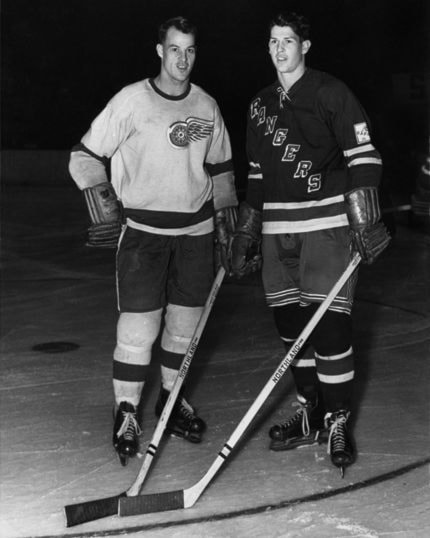Gordie Howe’s younger brother Vic, who died January 31 in Moncton at age 85, once played for the Nelson Maple Leafs.
His lone season here was 1955-56. The previous season he enjoyed his longest and final NHL stint: 29 games with the New York Rangers.
Howe’s arrival in Nelson at age 25 was probably due to the fact the team’s coach was former New York Rangers goaltender Chuck Rayner. Another teammate, Joe Bell, was also an ex-Ranger.
In 29 games with the senior Maple Leafs, Howe scored 10 goals and added 12 assists. He scored one goal in five playoff games.
The following is an excerpt from a column by John Short that appeared in the Nelson Daily News late in the regular season, after Howe was “finally given a chance to play regularly [and] caught fire” in a game against Trail.
“Vic’s outstanding performance was many times more heartening because of the rapid approach of the playoffs. For the same reason, his previously unsatisfactory performance had been many times more disappointing.
“Vic was tossed on a line with Fritz Koehle and Lee Hyssop and he looked like the Vic Howe who played in the National Hockey League last season ... I would like to pat Chuck Rayner on the back for his persistence in playing Vic. I know that many so-called hockey experts believed he should have been lopped off the roster.
“Vic was under tremendous pressure just as he has been ever since he joined the Leafs ... A big, free-wheeling skater, Vic is the best passer on the club. Time and again in Trail he hit Fritz Koehle, Lee Hyssop, in fact nearly ever man in a green sweater, with perfect passes.
“He still is having horrible luck around the net. In the first period he backhanded a shot that bounced off Seth Martin’s pads, hit the inside of the goal post and stayed out. Perhaps Vic was asking himself at that time: ‘Am I ever going to get moving?’ If he did ask that question, he soon gave himself the answer.
“Vic has been tarred by the same brush with which NHL critics have taken swipes at his brother Gordie. Fans in Nelson have often been heard to call him lazy, lackadaisical or ‘just plain overrated.’”
“He is none of those things. He is an earnest hockey player with major league ability who has had difficulty living down comparisons with his brother.
“If Vic does not possess Gordie Howe’s magnificent ability, who can blame him? After all, immortals like Gord come along once in many, many years.”
The following year Vic departed to play pro hockey in England.
LANGHAM’S LOOSE ENDS: What I originally envisioned as a two-part series on the history of the Langham Cultural Centre in Kaslo quickly grew to nine parts including contributions from three people who know the building intimately. Overall, it ran to more than 10,000 words online and a bit less in print. (The final installment appeared this week.)
My thanks to Ian Fraser, Michael Guthrie, and Maggie Tchir for their contributions and for supplying photos, as well as to Elizabeth Scarlett and Barbara Bavington of the Kootenay Lake Historical Society, plus Mary Johnson, Naomi Miller, Isabel Ramsay, and Jennifer Small for sharing their knowledge about the building and the people who lived there.
Two follow-up items: one instalment stated the Langham gets no government money. In fact, it does receive some minimal provincial funding, although it is mainly financed by the Langham Cultural Society and private donations.
Also, Elizabeth Scarlett reminded me of a major event that occurred at the Langham on August 6, 1988 just prior to the Japanese Canadian redress settlement, called Writing the Wrong. It was then that a plaque was unveiled on the side of the building outlining its role in the internment.
Bernadette Lynch, then the Langham’s director, organized the event.
“Bernadette worked hard to push for redress and this public event was Kaslo’s way of bringing the story of the Japanese Canadian internment to the fore,” Scarlett says.
